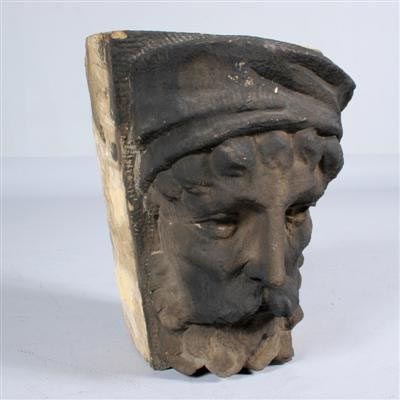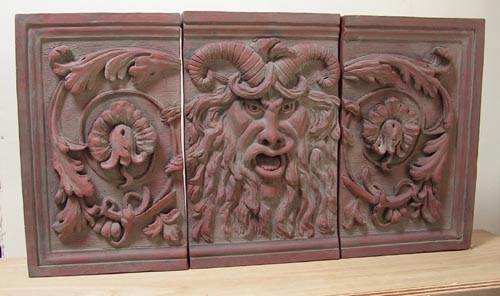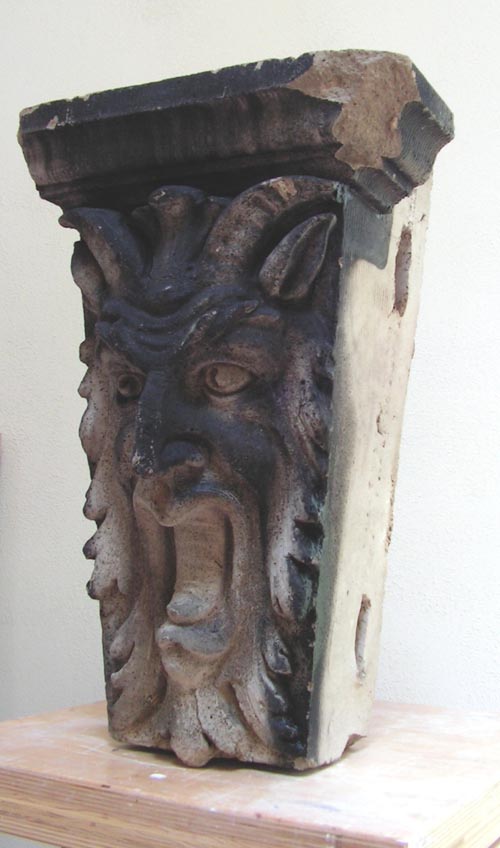
LOST THING  |
OCTOBER 2007 – NO. 18 |
|
|
Those New York City Faces
Between roughly 1870 and 1900, New York City was the destination for throngs
of newly arriving destitute Jewish, Italian, German, and Norwegian immigrant
families. These new residents needed housing quickly, and the solution was the
walk-up tenement building. Rapid and cheap to build, an estimated 100,000 of
them were occupied by the 1910s, when this design was phased out.
While interiors were drab and run-down, almost all of these buildings' exteriors were ornamented in some way with an astonishing variety of stone carvings, terra cotta sculptures, cast-iron, and other decorative elements representing the Victorian style of the period.
Upon demolitions of hundreds of these buildings in the 1970s, most of these ornaments wound up in the landfill. One 13 year old, however, began saving a significant portion of these from the landfill. Between 1974 and 1979, over 50 tons worth of gargoyles, chimera, grotesque keystones, cast-iron, wood carvings, and more found their way into several of this teen's storage lofts around the city. Years later, these treasures naturally followed that teen, now an adult sculptor specializing in — you guessed it — Victorian and Art architectural models.
While the original 50 ton collection was sold in the late '80s, a website full of photos of many of the pieces and the buildings they came from, along with casts made from new models, is located at lostnewyorkcity.com.

Goat: This is a 32" red terra cotta Dutch Landrace goat head sculpture
from the George Hauck brewery in Kingston, NY (1884-1941). The sculpture was
the company logo, this was probably hand-sculpted for Mr. Hauck, not made in
a mold. Originally salvaged in the 1940s by the woman who owned the demolition
company, it was passed down through the family like a family heirloom. I purchased
it from a family member who had it in his backyard near Kingston, NY, leaning
against a tree for at least the last 20 years. I hired a UPS store there to
get it, crate it, and ship it to me.

145-8: A typical size window keystone made of terra cotta, circa 1900 from the
Lower East Side of Manhattan. Carved stone keystone from 308 West 145th Street
Between 8th Avenue and Edgecombe in Harlem. I salvaged this when I was 16.
Plate-88-b

#649: Three-piece spandrel panel, cast in stone by me from a clay model that
was originally salvaged from 288 and 286 East 3rd Street, near Avenue C. Spandrel
panels were typically installed under windowsills. The model was done from a
photo of the original.

"Elizabeth": Modeled from a photo of a spandrel panel that was salvaged
from a building on 120th Street and Park Avenue in Harlem. The building dated
to 1888 and was given the name "Elizabeth" in a long terra cotta frieze
on an upper floor. My guess is she was the original owner's wife, sister, or
mother.

#785 Grotesque: purchased from a woman in New York via email this summer. I
have no idea of its original installation other than that it came to her from
a man who did demolition and construction work and had several salvaged pieces
laying in the back yard.
Original art courtesy Randall Dana.
